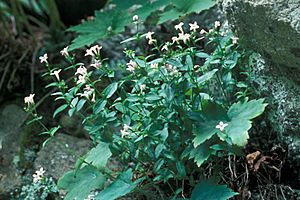Venus's pride facts for kids
Quick facts for kids Venus's pride |
|
|---|---|
 |
|
| var. montana | |
| Conservation status | |
| Scientific classification | |
| Kingdom: | |
| (unranked): | |
| (unranked): | |
| (unranked): | |
| Order: | |
| Family: | |
| Genus: |
Houstonia
|
| Species: |
H. purpurea
|
| Binomial name | |
| Houstonia purpurea |
|
| Synonyms | |
|
Hedyotis purpurea |
|
The Houstonia purpurea is a beautiful flowering plant. You might know it by its other names like Venus's pride, woodland bluet, or purple bluet. It belongs to the coffee family of plants. This plant naturally grows in the eastern United States. You can find it from Texas and Oklahoma all the way east to Florida and Pennsylvania. Sometimes, you can also spot it in places like Nebraska, Iowa, Michigan, New York State, and New England.
Contents
About the Purple Bluet
The Houstonia purpurea is a type of plant that produces lovely flowers. It's part of a big group of plants called the coffee family, which includes many well-known plants. This plant is known for its pretty purple or blue flowers.
Where It Grows Naturally
This plant is native to a large area in the eastern part of the United States. It grows in many different states. You can find it in the warmer southern states like Florida and Texas. It also grows further north in states like Pennsylvania and even in parts of New England.
Special Varieties of the Plant
There are three slightly different types, or varieties, of the Houstonia purpurea plant. One of these varieties is very special and quite rare. This rare type is called var. montana, and it's also known as the Roan Mountain bluet.
The Endangered Roan Mountain Bluet
The Roan Mountain bluet (var. montana) is a very important plant because it is a endangered species. This means there are very few of them left in the wild. The United States government has listed it as an endangered species to help protect it.
This rare plant only grows in a specific area. You can find it in the southern Appalachian Mountains. It lives right on the border between the states of Tennessee and North Carolina. It gets its name from Roan Mountain, which is one of the few mountain peaks where it can be found. Protecting this plant helps keep our natural world diverse and healthy.
See also
 In Spanish: Houstonia purpurea para niños
In Spanish: Houstonia purpurea para niños




